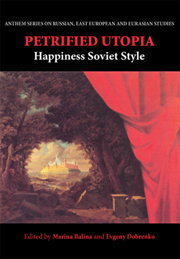Book contents
- Frontmatter
- Contents
- List of Illustrations
- Acknowledgments
- List of Contributors
- Introduction
- Petrified Utopia
- Part One Utopics
- 1 A Joyful Soviet Childhood: Licensed Happiness for Little Ones
- 2 Utopian Naturalism: The Epic Poem of Kolkhoz Happiness
- 3 Luxuriating in Lack: Plentitude and Consuming Happiness in Soviet Paintings and Posters, 1920s–1953
- 4 Tasty and Healthy: Soviet Happiness in One Book
- Part Two Realities
- Part Three Locations
- Notes
- Index
2 - Utopian Naturalism: The Epic Poem of Kolkhoz Happiness
from Part One - Utopics
Published online by Cambridge University Press: 05 March 2012
- Frontmatter
- Contents
- List of Illustrations
- Acknowledgments
- List of Contributors
- Introduction
- Petrified Utopia
- Part One Utopics
- 1 A Joyful Soviet Childhood: Licensed Happiness for Little Ones
- 2 Utopian Naturalism: The Epic Poem of Kolkhoz Happiness
- 3 Luxuriating in Lack: Plentitude and Consuming Happiness in Soviet Paintings and Posters, 1920s–1953
- 4 Tasty and Healthy: Soviet Happiness in One Book
- Part Two Realities
- Part Three Locations
- Notes
- Index
Summary
… essential, it seems,
That a poem's style fit its themes.
– Nikolai Nekrasov, Imitation of Schiller1
Soviet ‘Great Style’ is primarily associated with the ‘grand’ genre forms. In painting, this means ceremonial portraits and battle scenes; in music, it means opera, oratorios, cantatas, symphonies; in city planning, architectural complexes; in prose, novels; and in poetry, the epic poem. As a sort of narrative in verse, the epic poem, like operas and programmatic music, was narrative in form, and the connection to heroic style made it the embodiment of ‘epic thinking’, and made it especially close to the Socialist Realist aesthetic-much closer than lyric poetry, and it was no coincidence that the first glimmers of the thaw in Soviet literature were connected precisely to the ‘discussion about lyric poetry’. The genre hierarchy in Stalinism can infallibly be reconstructed according to the preferences in awarding the Stalin Prizes (Stalin, as is well known, personally participated in distributing these prizes). Thus, in the period spanning 1934 to 1952, there was not a single year in which a Stalin Prize for poetry was not conferred on an epic poem (the others were for poem cycles, anthologies of poetry, lyrics of popular songs, and translations of poetry).
- Type
- Chapter
- Information
- Petrified UtopiaHappiness Soviet Style, pp. 19 - 52Publisher: Anthem PressPrint publication year: 2009



